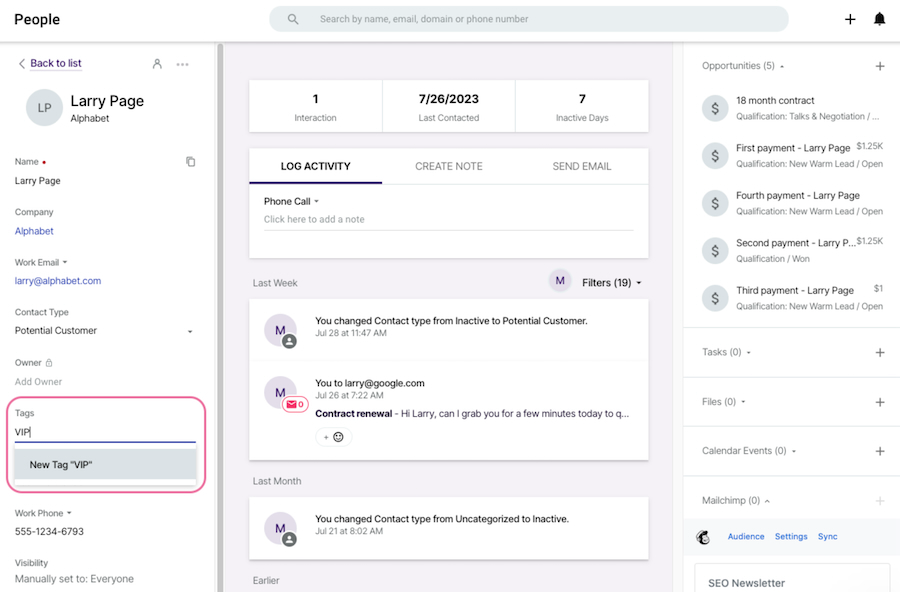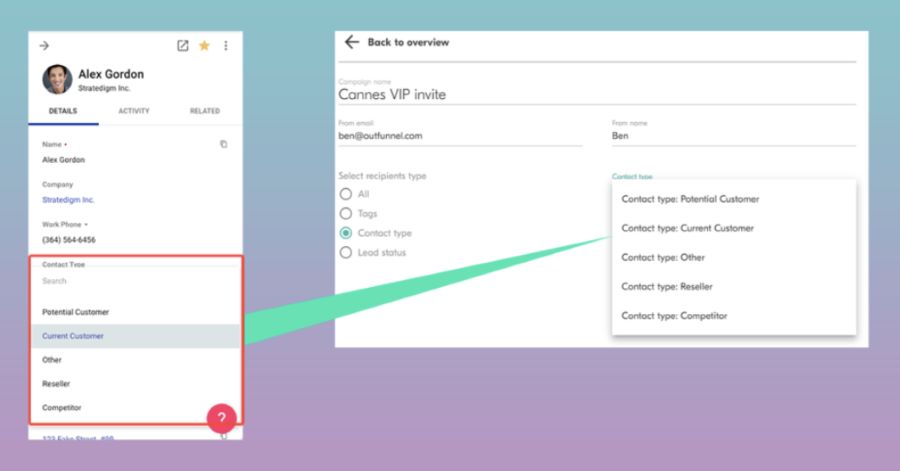A customer persona is a tool that helps define your company’s ideal buyer types and guides your lead generation and marketing activities. Developing customer personas involves identifying characteristics such as the profession, demographics, behaviors, and interests of preferred buyers. You can also give your business persona a fictional name as an easy way for your sales and marketing teams to better identify and target prospects that fit certain profiles.
What is a customer persona vs a customer profile?
Customer personas, also called buyer personas, are fictional representations of a company’s ideal target customers that can include demographic information. Customer profiles, on the other hand, include details about real individuals, groups, or companies that are most likely to buy from your company.
Free Customer Persona Template Download
We’ve created a free buyer persona template to help you better define your ideal customers and implement more effective sales and marketing strategies. This template lays out the sections you need to create unique customer profiles. Download this template and use it as you follow the five easy steps below on how to create a customer persona for your business.
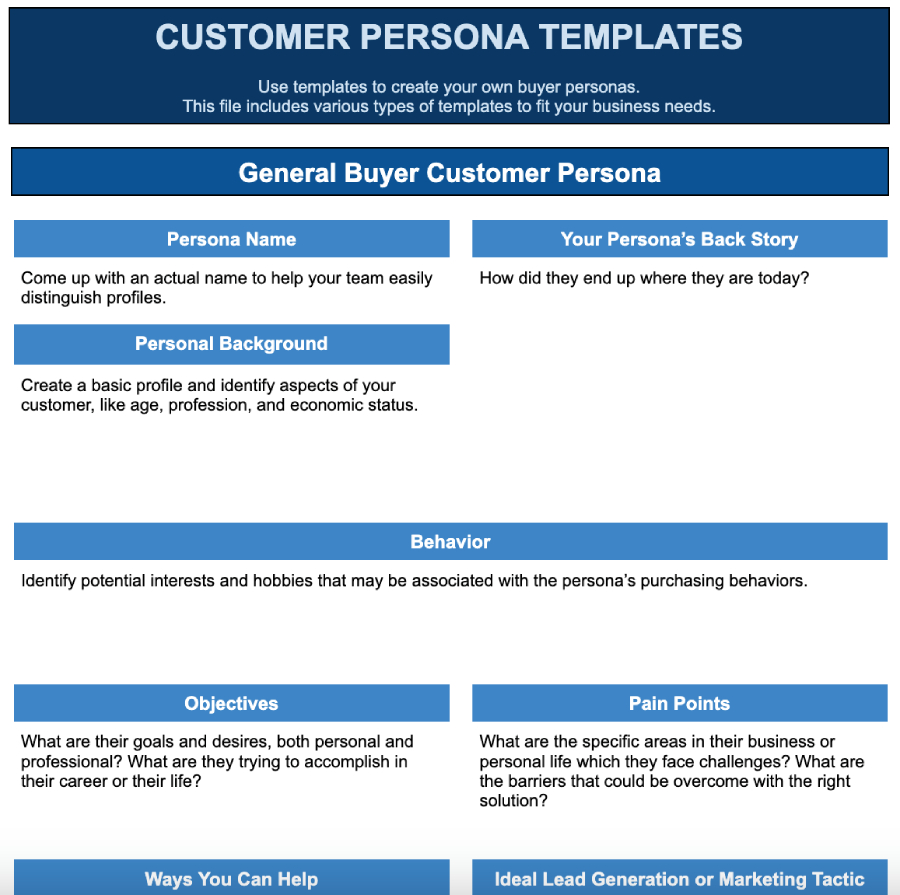
Thank you for downloading!
💡 Quick Tip:
Customer relationship management (CRM) systems like HubSpot CRM allow you to store customer persona information and use tagging features to add traits to each prospect–making it easier to segment your customers into personas.
Use HubSpot CRM’s Make My Persona tool to generate FREE professional buyer personas for your business.
1. Define the Traits of Your Ideal Customer
Regardless of the wide variety of customer types your business has, think about what your “perfect” (or ideal) customer archetype looks like. Do this by evaluating who your product or service is designed for and researching the target markets of similar products or services. The traits of your ideal buyers should define things like demographics, behaviors, interests, pain points, objectives, and job roles.
An essential part of all effective sales management strategies is targeting your efforts around specific customer marketing personas. This allows you to address common objectives or tailor messaging, which helps to shorten the buying cycle and improve lead generation and sales. It also saves you time from chasing after leads that will never convert to paying customers.
For example, you want to sell your project management tool to project managers. Your team comes up with the name “Patty the Project Manager.” Based on their research, this type of customer is between 35 and 50 years old, has a bachelor’s degree, is currently married with two kids, and earns around $80,000 per year. She’s described as a manager who juggles several projects and wants to increase productivity but has no time to see a product demo.
2. Gather Information About Current Customers
If you have a robust sample of existing customers, look for common demographics or job roles shared by most customers. As you gather and review current customer data, you may also find that customers are often generated from various lead sources, such as a trade show, online web forms, or outbound sales prospecting. Personas will reflect common traits and lead sources, since typical lead sources are also useful for future marketing.
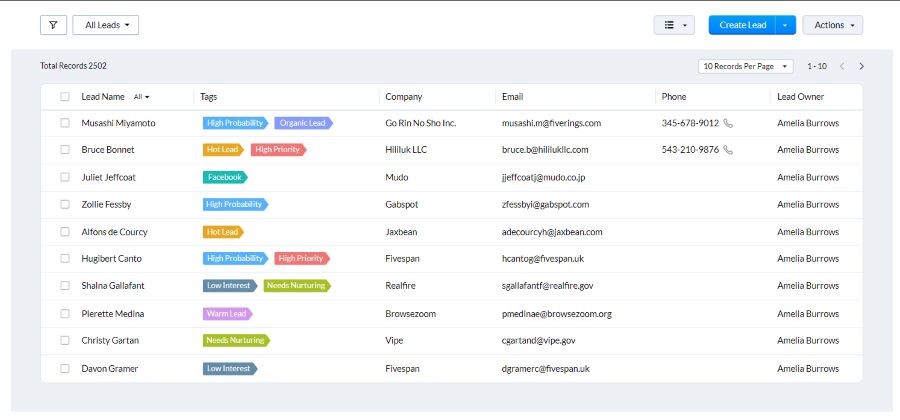
Zoho CRM tagging leads to segment and profile them (Source: Zoho CRM)
3. Segment Your Customer Profiles
Once you understand the shared traits of your ideal buyers, the next step in how to write a customer persona is to identify existing customers matching those traits. To do this, assign customers to segments based on their attributes. You can use a spreadsheet, but many CRMs have prebuilt fields for contact management that make this step easier. It’s also worth noting that customers may fall into multiple customer segments if they fit more than one profile.
For example, you may find patterns showing customers aged 25 to 45 make up a large portion of your revenue, with women in that group ranging in age from 30 to 35 comprising the majority. Therefore, you could have two customer profile segments, one being all people from 24 to 45 in age and another being women aged 30 to 35, with women aged 30 to 35 falling into both categories.
Another example of segmentation could be if you found one group of customers who immediately purchased from your business after seeing a product demonstration. You can then see whether the fast-purchasing customers share similar attributes, such as background, role, or pain points, and create a segment based on that factor.
4. Build Unique Buyer Persona Profiles
Once you have segments based on customer similarities, you are now ready for the process of creating buyer personas representing your most common and ideal buyer types. First, add the relevant attributes that make up the ideal customer. After the customer traits are added, give your business persona a name that’s simple and easy to remember. You’ll find some consumer persona examples below.
Few companies have only one ideal customer, so most businesses will have multiple consumer personas showing their most common buyer types. This further enables you to diversify your sales and marketing strategies by profile and to account for cyclical sales. For example, marketing to one persona may generate robust sales during the winter holiday season, but another may be more likely to buy during the summer months.
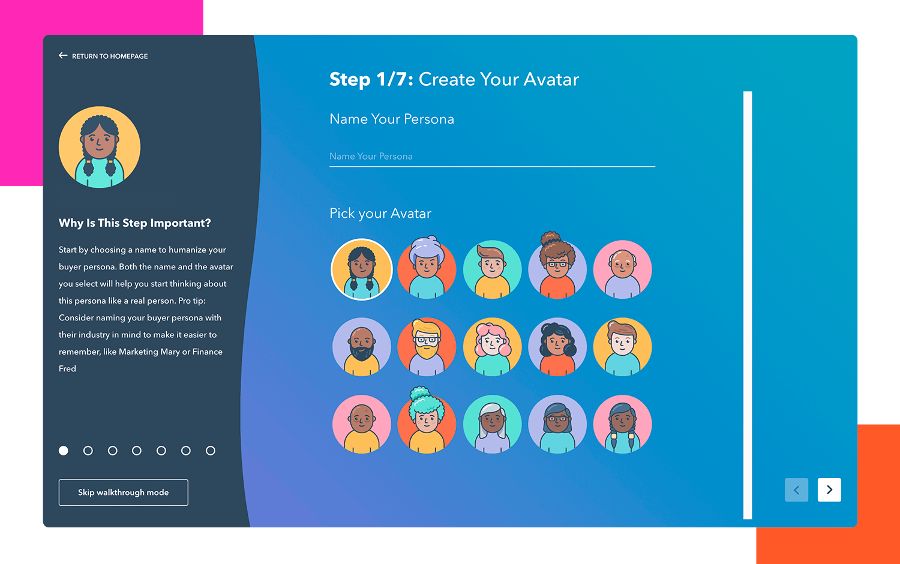
HubSpot CRM’s Make My Persona Tool lets you create and save buyer personas in the system. (Source: HubSpot)
5. Set Sales & Marketing Strategies for Each Buyer Persona
Personas allow you to determine the best ways to generate leads and convert them into paying customers. Once you have detailed business personas, create and adjust your sales and marketing strategies and the tactics needed to get each particular persona into and through the sales process.
Here are some examples of sales and marketing tactics that you can fine-tune based on different buyer personas:
Consumer Persona Samples
Consumer personas are especially useful before lead generation as they inform the outreach and marketing approach of a business. Each sample customer persona enables you to strategically develop tactics for acquiring leads among people matching your most-wanted buyer types.
Here are things to consider when building your business persona profiles:
Take into account the elaborate details of each persona. The more detailed the information, the better you can narrow in on sales and marketing strategies that align with the unique needs and priorities of the business or customer.
Why Create a Customer Persona?
A customer personas template can be instrumental in growing your business by increasing sales through strategy adjustments and execution. Using personas can also improve the overall customer experience by providing team members with a solid understanding of the objectives and pain points common to your buyer types.
Here are some benefits of using consumer personas:
Persona information allows you to identify and focus on the most effective marketing channels, methods, and specific content for each profile. Personas provide useful insights into the behavior of your target audience. This could include the channels they prefer for online conversations and the topics they are interested in.
The information in buyer profiles allows your sales team to determine the best way to reach a lead and which sales methods to use. It also informs your business on which value propositions to emphasize, the objections they are likely to encounter, and the best approach for closing business. For example, your sales reps should highlight your low-priced products or services when dealing with cost-conscious customers.
Based on a business persona, you can enhance your products or services to alleviate pain points. You can reinforce intrinsic value, provide differentiation, and help the lead accomplish their objectives. In the previous section, the customer persona example of Frugal Frank wants to replace some of their vendors with more affordable solutions. To address this pain point, you could adjust your prices or offer a package with more value for the same price.
If a persona indicates a behavior or interest related to dealing with customer support, you can use that information to make adjustments to your customer service operations. This can include identifying their preferred mode of communication. For example, if your target audience prefers talking over the phone, your team can spend less time communicating with them via social media.
Frequently Asked Questions (FAQs)
The four types of customer personas are competitive, spontaneous, humanistic, and methodical. The competitive persona is always on the lookout for the advantages of your business, while the spontaneous persona will most likely make a quick purchase if your product feels right. The humanistic persona makes emotional buying decisions, and the methodical persona makes logical buying decisions based on the fine details of a product or service.
A good persona will provide you with meaningful information about your target customers, including what they want and need. It will serve as your cheat sheet for customizing business decisions and activities that impact your customers.
The two types of consumer personas are proto (provisional) and full. The proto persona is used to define predictable details about your target consumer and their fundamental problems. It does not have to be precise since it is supposed to be simple and quickly constructed. A full persona, on the other hand, presents detailed information on your target market’s problems and needs, as well as the marketplace, future trends, and your competitors.
Bottom Line
Creating buyer personas is an excellent way to identify the types of buyers you want to attract and the best strategies for acquiring them. Download our free customer persona template and follow our five-step guide on how to create customer personas for your business. Then adjust your marketing and sales strategies and improve your products, services, and customer support based on the objectives, pain points, interests, and behaviors defined in each customer profile.

Thank you for downloading!
💡 Quick Tip:
Customer relationship management (CRM) systems like HubSpot CRM allow you to store customer persona information and use tagging features to add traits to each prospect–making it easier to segment your customers into personas.
Use HubSpot CRM’s Make My Persona tool to generate FREE professional buyer personas for your business.
